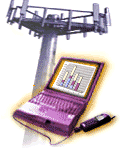 |
RESEARCHWireless Systems Laboratory provides research support and education in wireless transmission systems and networks. Two examples are included below. |
 |
RESEARCHWireless Systems Laboratory provides research support and education in wireless transmission systems and networks. Two examples are included below. |
| Wireless Geophone Networks |
Traditional seismic data acquisition systems rely on telemetry cables in conducting oil and gas exploration/monitoring. Although cabled systems provide reliable seismic data transfer, their deployment and maintenance costs are increasing substantially as surveys become larger in scale and densely populated. Furthermore, the complex environment in certain survey areas makes cabled systems expensive and impractical. Cables account for a majority of the cost and the weight of a typical land survey. A significant amount of time is spent in troubleshooting problems related to the cables and connectors.
Wireless geophone network architectures based on smart wireless geophones can be developed to tackle the problems associated with cabled systems. Near-earth and mm-wave propagation models for specific frequency bands under various weather and terrain conditions are investigated. Furthermore, an analysis of the link budget, cell sizes, frame error rate is carried out. Energy-aware algorithms are also studied to extend the operational life of the geophones.
| Channel Modeling |
Mobile-to-Mobile Communication Radio Channel Modeling
The past decade or so has witnessed tremendous growth in mobile communications due to its ability to provide communications to people on the move. Such mobile links communicate between a fixed i.e. stationary base station and a mobile user. In this sense, the mobility is limited at user end only for all present day mobile radio links. However, future applications and trends portend the need for direct communication between mobile users without need for central base stations in order to provide greater mobility, flexibility and convenience of usage. Such systems are termed mobile-to-mobile (M2M) or doubly mobile systems. They find applications in military as well as commercial arena in form of ad-hoc mobile wireless networks, intelligent vehicle systems and broadband highway communications. To enable design of such systems, our research has focused on study and characterization of radio propagation channels for M2M links. The main issues addressed are:
- Development of wideband M2M channel models that characterize power delay profiles and power-delay-angle spectra based on data available through field trials
- Development of methods to simulate M2M channels in software
- Development of MIMO M2M channel models, analysis, and simulation
- Methods for modeling vehicle scattering, in which the vehicles are either surrounding or are in between the transmitter and receiver.
Polarized Channel Modeling
Multi-polarized antennas have attracted considerable attention as a means for increasing channel capacity and reducing the required antenna spacing through the principle of polarization diversity. Such antennas exploit depolarization and have the potential to double or triple the channel capacity that is achievable with single-polarized antennas. In practice, cellular land mobile radio systems have employed slant polarized array antennas at the base stations to good benefit. Our research has developed a geometrical theory for depolarization in fixed-to-mobile (F2M) and M2M wireless channels. This novel theory reveals the origin of channel depolarization and provides a mechanism for computing crosspolarization discrimination (XPD). Based on the superposition of polarization components on conservation-of-polarization planes, a three-dimensional (3-D) geometry-based reference model has been developed for determining the observed XPD. This purely theoretical approach can be used to derive the XPD without the aid of measurement data or its approximation. The geometrical theory and reference model provide a relationship between channel depolarization or XPD and channel modeling factors such as the distance between the transmitter and the receiver, the azimuth/elevation angles of arrival and departure, and the distribution of scatterers around the transmitter and/or receiver.
mm-wave Channel Modeling
In recent years, new spectrum allocations in the millimeterwave (mm-wave) bands have driven the development of the fifth-generation (5G) wireless communications, due to the rapidly increasing demands for high data rates. The mm-waves have been used extensively for point-to-point satellite communications, and now receive much attention for commercial communication systems. Current applications of mm-wave communications include wireless backhaul, cellular hotspot coverage, wireless personal area networks, wireless local area networks, sensor networks, etc. Recently, mm-wave mobile-to-mobile (M2M) communications have gained strong momentum, as it enables Gbps communications for the future intelligent transportation systems, where a large number of sensors will be incorporated into vehicles and a huge amount of data needs to be transmitted via wireless communications. The main issues are:
Unlike lower frequencies, mm-wave communications are vulnerable to blocking. The vulnerability to blocking of mm-wave signals has significant impact on M2M applications, as in M2M scenarios the transmitter and receiver are usually equipped with low antennas and the blocking effects are much more severe.
In M2M scenarios, since the trajectories of transmitter and receiver are usually random, omnidirectional antennas in azimuth have been widely used before so that good link connection can be guaranteed. This differs from some cellular mm-wave applications, where directional antennas at the transmitter and/or receiver are usually used. For mm-wave M2M communications, antenna patterns can be focused over a narrower beamwidth in elevation, which improves coverage at mmWave bands. Furthermore, for some safety related applications of vehicular mm-wave M2M communications, e.g., collision warning, directional antennas in azimuth can be used at both the front and rear of the vehicle to increase gain. Therefore, channel models incorporating both omnidirectional and directional antennas are needed for mm-wave M2M communications.
Home | About WSL | Director | Personnel | Research | Grants and Projects | Publications | Courses | Wireless on the Web | Help | Feedback | Direction
More information or problems with this page? Please contact Gordon L. Stüber
This
page has been accessed
times since January 14, 2003.
This page was last modified on
.
Copyright (C) 1999-2000 WSL, Georgia Tech. All Rights Reserved.